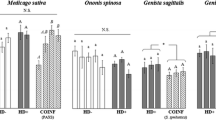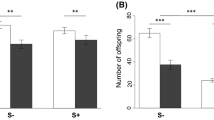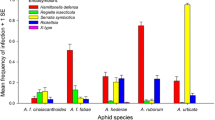Abstract
Ecological specialisation on different host plants occurs frequently among phytophagous insects and is normally assumed to have a genetic basis. However, insects often carry microbial symbionts, which may play a role in the evolution of specialisation. The bacterium Regiella insecticola is a facultative symbiont of pea aphids (Acyrthosiphon pisum) where it is found most frequently in aphid clones feeding on Trifolium giving rise to the hypothesis that it may improve aphid performance on this plant. A study in which R. insecticola was eliminated from a single naturally infected aphid clone supported the hypothesis, but a second involving two aphid clones did not find the same effect. We created a series of new pea aphid–R. insecticola associations by injecting different strains of bacteria into five aphid clones uninfected by symbionts. For all aphid clones, the bacteria decreased the rate at which aphids accepted Vicia faba as a food plant and reduced performance on this plant. Their effect on aphids given Trifolium pratense was more complex: R. insecticola negatively affected acceptance by all aphid clones, had no effect on the performance of four aphid clones, but increased performance of a fifth, thus demonstrating genetic variation in the effect of R. insecticola on pea aphid host use. We discuss how these results may explain the distribution and frequency of this symbiont across different aphid populations.

Similar content being viewed by others
References
Bush GL (1969) Sympatric host race formation and speciation in frugivorous flies of the genus Rhagoletis (Diptera: Tephritidae). Evolution 23:237–251
Caillaud MC, Via S (2000) Specialized feeding behavior influences both ecological specialization and assortative mating in sympatric host races of pea aphids. Am Nat 156:606–621
Chen DQ, Purcell AH (1997) Occurrence and transmission of facultative endosymbionts in aphids. Curr Microbiol 34:220–225
Chen DQ, Montllor CB, Purcell AH (2000) Fitness effects of two facultative endosymbiotic bacteria on the pea aphid, Acyrthosiphon pisum, and the blue alfalfa aphid, A. kondoi. Entomol Exp Appl 95:315–323
Darby AC, Douglas AE (2003) Elucidation of the transmission patterns of an insect-borne bacterium. Appl Environ Microbiol 69:4403–4407
Douglas AE (1998) Nutritional interactions in insect-microbial symbioses: aphids and their symbiotic bacteria Buchnera. Annu Rev Entomol 43:17–37
Drès M, Mallet J (2002) Host races in plant-feeding insects and their importance in sympatric speciation. Philos Trans R Soc B Biol Sci 357:471–492
Ferrari J, Godfray HCJ (2003) Resistance to a fungal pathogen and host plant specialization in the pea aphid. Ecol Lett 6:111–118
Ferrari J, Godfray HCJ (2006) The maintenance of intraspecific biodiversity: the interplay of selection on resource use and on natural enemy resistance in the pea aphid. Ecol Res 21:9–16
Ferrari J, Darby AC, Daniell TJ, Godfray HCJ, Douglas AE (2004) Linking the bacterial community in pea aphids with host-plant use and natural enemy resistance. Ecol Entomol 29:60–65
Ferrari J, Godfray HCJ, Faulconbridge AS, Prior K, Via S (2006) Population differentiation and genetic variation in host choice among pea aphids from eight host genera. Evolution 60:1574–1584
Frantz A, Plantegenest M, Mieuzet L, Simon J-C (2006) Ecological specialization correlates with genotypic differentiation in sympatric host-populations of the pea aphid. J Evol Biol 19:392–401
Haynes S, Darby AC, Daniell TJ, Webster G, van Veen FJF, Godfray HCJ, Prosser JI, Douglas AE (2003) Diversity of bacteria associated with natural aphid populations. Appl Environ Microbiol 69:7216–7223
Hawthorne DJ, Via S (2001) Genetic linkage of ecological specialization and reproductive isolation in pea aphids. Nature 412:904–907
Leonardo TE (2004) Removal of a specialization-associated symbiont does not affect aphid fitness. Ecol Lett 7:461–468
Leonardo TE, Mondor EB (2006) Symbiont modifies host life-history traits that affect gene flow. Proc R Soc B Biol Sci 273:1079–1084
Leonardo TE, Muiru GT (2003) Facultative symbionts are associated with host plant specialization in pea aphid populations. Proc R Soc B Biol Sci 270:S209–S212
Montllor CB, Maxmen A, Purcell AH (2002) Facultative bacterial endosymbionts benefit pea aphids Acyrthosiphon pisum under heat stress. Ecol Entomol 27:189–195
Mopper S, Strauss SY (1998) Genetic structure and local adaptation in natural insect populations: effects of ecology, life history, and behavior. Chapman and Hall, New York
Moran NA, Baumann P (2000) Bacterial endosymbionts in animals. Curr Opin Microbiol 3:270–275
Moran NA, Dunbar HE (2006) Sexual acquisition of beneficial symbionts in aphids. Proc Natl Acad Sci USA 103:12803–12806
Moran NA, Russell JA, Koga R, Fukatsu T (2005) Evolutionary relationships of three new species of Enterobacteriaceae living as symbionts of aphids and other insects. Appl Environ Microbiol 71:3302–3310
Müller FP (1962) Biotypen und Unterarten der “Erbsenlaus” Acyrthosiphon pisum (Harris). Z Pflanzenkd Pflanzensch—J Plant Dis Prot 69:129–136
Oliver KM, Russell JA, Moran NA, Hunter MS (2003) Facultative bacterial symbionts in aphids confer resistance to parasitic wasps. Proc Natl Acad Sci USA 100:1803–1807
Oliver KM, Moran NA, Hunter MS (2005) Variation in resistance to parasitism in aphids is due to symbionts not host genotype. Proc Natl Acad Sci USA 102:12795–12800
Oliver KM, Moran NA, Hunter MS (2006) Costs and benefits of a superinfection of facultative symbionts in aphids. Proc R Soc B Biol Sci 273:1273–1280
Russell JA, Moran NA (2006) Costs and benefits of symbiont infection in aphids: variation among symbionts and across temperatures. Proc R Soc B Biol Sci 273:603–610
Russell JA, Latorre A, Sabater-Muñoz B, Moya A, Moran NA (2003) Side-stepping secondary symbionts: widespread horizontal transfer across and beyond the Aphidoidea. Mol Ecol 12:1061–1075
Sandström J (1996) Temporal changes in host adaptation in the pea aphid, Acyrthosiphon pisum. Ecol Entomol 21:56–62
Sandström J, Pettersson J (1994) Amino-acid-composition of phloem sap and the relation to intraspecific variation in pea aphid (Acyrthosiphon pisum) performance. J Insect Physiol 40:947–955
Sandström JP, Russell JA, White JP, Moran NA (2001) Independent origins of horizontal transfer of bacterial symbionts of aphids. Mol Ecol 10:217–228
Scarborough CL, Ferrari J, Godfray HCJ (2005) Aphid protected from pathogen by endosymbiont. Science 310:1781
Simon J-C, Carré S, Boutin M, Prunier-Leterme N, Sabater-Muñoz B, Latorre A, Bournoville R (2003) Host-based divergence in populations of the pea aphid: insights from nuclear markers and the prevalence of facultative symbionts. Proc R Soc B Biol Sci 270:1703–1712
Tsuchida T, Koga R, Fukatsu T (2004) Host plant specialization governed by facultative symbiont. Science 303:1989–1989
Tsuchida T, Koga R, Shibao H, Matsumoto T, Fukatsu T (2002) Diversity and geographic distribution of secondary endosymbiotic bacteria in natural populations in the pea aphid, Acyrthosiphon pisum. Mol Ecol 11:2123–2135
Via S (1991) The genetic structure of host plant adaptation in a spatial patchwork—demographic variability among reciprocally transplanted pea aphid clones. Evolution 45:827–852
Via S (1999) Reproductive isolation between sympatric races of pea aphids. I. Gene flow restriction and habitat choice. Evolution 53:1446–1457
Via S (2001) Sympatric speciation in animals: the ugly duckling grows up. Trends Ecol Evol 16:381–390
Via S, Bouck AC, Skillman S (2000) Reproductive isolation between divergent races of pea aphids on two hosts. II. Selection against migrants and hybrids in the parental environments. Evolution 54:1626–1637
Acknowledgements
C. L. S. was supported by a NERC studentship. Our work complied with UK law.
Author information
Authors and Affiliations
Corresponding author
Additional information
Communicated by Thomas Hoffmeister.
Julia Ferrari and Claire L. Scarborough contributed equally to the work.
Rights and permissions
About this article
Cite this article
Ferrari, J., Scarborough, C.L. & Godfray, H.C.J. Genetic variation in the effect of a facultative symbiont on host-plant use by pea aphids. Oecologia 153, 323–329 (2007). https://doi.org/10.1007/s00442-007-0730-2
Received:
Accepted:
Published:
Issue Date:
DOI: https://doi.org/10.1007/s00442-007-0730-2




